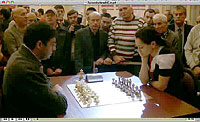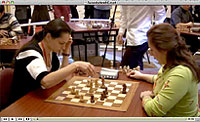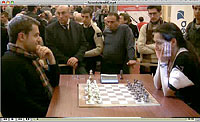Is space like a chess board?
Chess blog for latest chess news and chess trivia (c) Alexandra Kosteniuk, 2012
Hello everyone,
This Science Daily article did not make it to mainstream media last year but it's quite a read if you are fascinated by how chess applies to all aspects of our life. Enjoy.
Hello everyone,
This Science Daily article did not make it to mainstream media last year but it's quite a read if you are fascinated by how chess applies to all aspects of our life. Enjoy.
Physicists at UCLA set out to design a better transistor and ended up discovering a new way to think about the structure of space.
Space is usually considered infinitely divisible -- given any two positions, there is always a position halfway between. But in a recent study aimed at developing ultra-fast transistors using graphene, researchers from the UCLA Department of Physics and Astronomy and the California NanoSystems Institute show that dividing space into discrete locations, like a chessboard, may explain how point-like electrons, which have no finite radius, manage to carry their intrinsic angular momentum, or "spin."
While studying graphene's electronic properties, professor Chris Regan and graduate student Matthew Mecklenburg found that a particle can acquire spin by living in a space with two types of positions -- dark tiles and light tiles. The particle seems to spin if the tiles are so close together that their separation cannot be detected.
"An electron's spin might arise because space at very small distances is not smooth, but rather segmented, like a chessboard," Regan said.
Their findings are published in the March 18 edition of the journal Physical Review Letters.
In quantum mechanics, "spin up" and "spin down" refer to the two types of states that can be assigned to an electron. That the electron's spin can have only two values -- not one, three or an infinite number -- helps explain the stability of matter, the nature of the chemical bond and many other fundamental phenomena.
However, it is not clear how the electron manages the rotational motion implied by its spin. If the electron had a radius, the implied surface would have to be moving faster than the speed of light, violating the theory of relativity. And experiments show that the electron does not have a radius; it is thought to be a pure point particle with no surface or substructure that could possibly spin.
Space is usually considered infinitely divisible -- given any two positions, there is always a position halfway between. But in a recent study aimed at developing ultra-fast transistors using graphene, researchers from the UCLA Department of Physics and Astronomy and the California NanoSystems Institute show that dividing space into discrete locations, like a chessboard, may explain how point-like electrons, which have no finite radius, manage to carry their intrinsic angular momentum, or "spin."
While studying graphene's electronic properties, professor Chris Regan and graduate student Matthew Mecklenburg found that a particle can acquire spin by living in a space with two types of positions -- dark tiles and light tiles. The particle seems to spin if the tiles are so close together that their separation cannot be detected.
"An electron's spin might arise because space at very small distances is not smooth, but rather segmented, like a chessboard," Regan said.
Their findings are published in the March 18 edition of the journal Physical Review Letters.
In quantum mechanics, "spin up" and "spin down" refer to the two types of states that can be assigned to an electron. That the electron's spin can have only two values -- not one, three or an infinite number -- helps explain the stability of matter, the nature of the chemical bond and many other fundamental phenomena.
However, it is not clear how the electron manages the rotational motion implied by its spin. If the electron had a radius, the implied surface would have to be moving faster than the speed of light, violating the theory of relativity. And experiments show that the electron does not have a radius; it is thought to be a pure point particle with no surface or substructure that could possibly spin.
Labels: chess and space



































1 Comments:
At January 29, 2012 at 3:55 PM , alexis cochran, nz said...
alexis cochran, nz said...
no wonder there is all that alien stuff to do with chess huh
Post a Comment
Note: Only a member of this blog may post a comment.
Subscribe to Post Comments [Atom]
<< Home